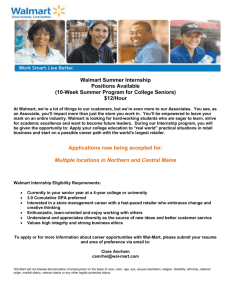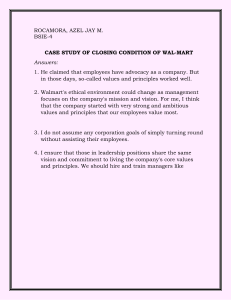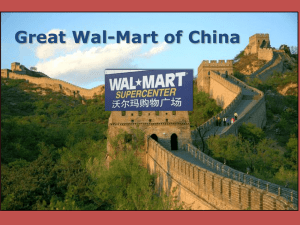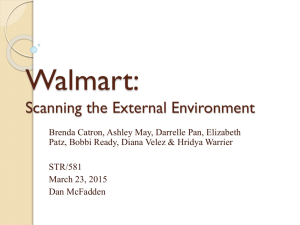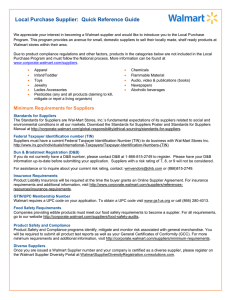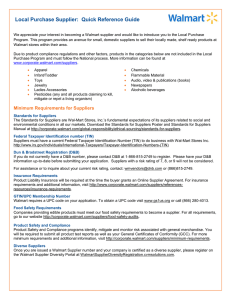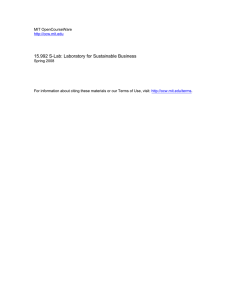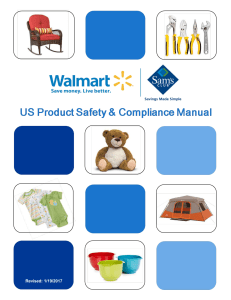Sales By Segment (In Billions)
advertisement
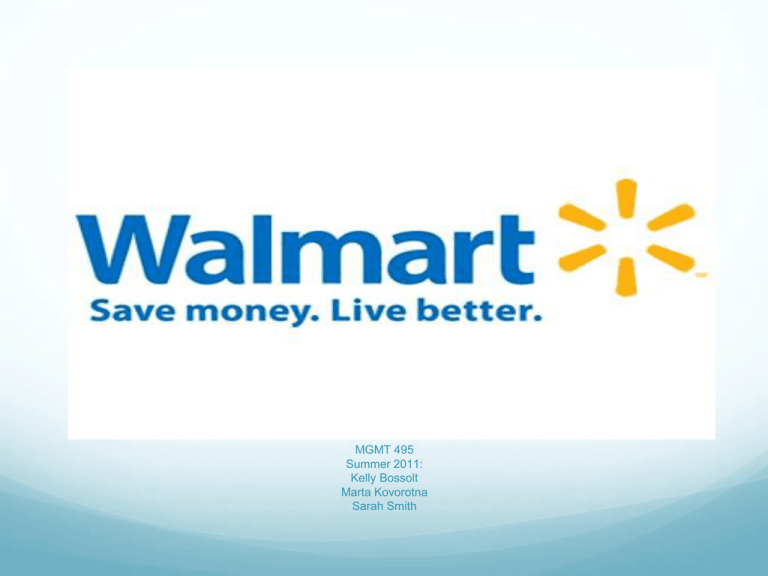
MGMT 495 Summer 2011: Kelly Bossolt Marta Kovorotna Sarah Smith Executive Summary Financial Analysis External Analysis Internal Analysis Technology Human Capital Competitive Advantages Recommendations Financial Analysis As of 2004 compared to top competitors Company: Revenue: Home Depot $65 Billion Target $50 Billion Walmart $250 Billion Harvard Business School, Wal-Mart, 2005, David B. Yoffie Financial Analysis As of 2011 compared to top competitors Company: Revenue: EBITDA: Home Depot (HD) $67 Billion 7.66B Target (TGT) $67 Billion 7.35B Sears (SHLD) $43 Billion 1.22B Walmart (WMT) $421 Billion 33.46B http://finance.yahoo.com/ Financial Analysis Walmart’s net sales over the years (In Billions): Net Sales 500 400 300 200 100 0 FY07 FY08 FY09 http://walmartstores.com/sites/annualreport/2011/sams_club.aspx FY10 FY11 Financial Analysis Sales By Segment (In Billions) 50 109 260 http://walmartstores.com/sites/annualreport/2011/sams_club.aspx Walmart US International Sam's Club External Analysis Wal-Mart – greedy for control Sophisticated ecosystem The growth feeds the ecosystem, the ecosystem powers the growth Market capitalism More than 30% of the entire market Customers vote Wal-Mart with wallets Suppliers vote with their products External Analysis Consumers One stop shoppers 90% Americans live within 15 miles 93% US households shopped in Wal-Mart Save up to $900 a year Conflicted customer Suppliers Huge part of ecosystem Weak bargaining power Failure to comply Vlasic example Procter & Gamble and Gillette 16% of their business External Analysis Competition Target, Home Depot, Costco Best Buy, Radio Shack Sears and Kmart merger Environment Destroying more jobs than creating Sustainability Eliminate 20 million metric tons of greenhouse gas (GHG) emissions from WalMart's global supply chain by the end of 2015. Zero Waste More sustainable products, at more affordable prices Internal Analysis: Technology Bar Coding Share info with in and across stores and to suppliers Electric Data Interchange (EDI) Forecasting, planning, replenishment, shipping Retail Link Required by suppliers – point of sale technology Internal Analysis: Technology Radio Frequency Identification (RFID) Reduced shrinkage, inventory tracking, time saver Online Pushed boundaries New products – music store, internet access Internal Analysis: Human Capital Criticisms Low pay, heavy part time reliance No unions Bad evaluation procedures Promote Good working conditions Competitive Advantage Technology Name Fortune’s most admired company in 2003 Philanthropic efforts International mergers and acquisitions Smart at entering potential markets Captures the culture and adapts (mostly) Recommendations Keep investing in Technology Employee incentives Don’t force culture too fast internationally
